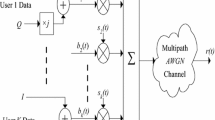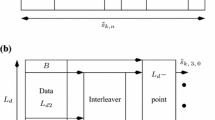Abstract
A new family of multistage low-complexity linear receivers for direct sequence code division multiple access (DS-CDMA) communications is introduced. The objective of the proposed design is to mitigate the effect of multiple access interference (MAI), the most significant limiting factor of user capacity in the conventional DS-CDMA channel. The receivers presented here employ joint detection of multiple users and therefore require knowledge of all the signature codes and their timing. In addition, for a multipath environment, reliable estimates of the received powers and phases are assumed available for maximal ratio RAKE combining. Each stage of the underlying design recreates the overall modulation, noiseless channel, and demodulation process. The outputs of these stages are then linearly combined. The combining weights can be chosen to implement different linear detectors, including the decorrelating and minimum mean square error (MMSE) detectors. In this paper, we focus on implementing the MMSE detector. Simulation results illustrate that significant performance gains can be achieved in both synchronous and asynchronous systems.
Similar content being viewed by others
References
W. C. Y. Lee, Overview of cellular CDMA,IEEE Transactions on Vehicular Technology, Vol. 40, No. 2, pp. 291–302, 1991.
K. S. Gilhousen, I. M. Jacobs, R. Padovani, A. J. Viterbi, L. A. Weaver, Jr., and C. E. Wheatly III, On the capacity of a cellular CDMA system,IEEE Transactions on Vehicular Technology, Vol. 40, No. 2, pp. 303–312, 1991.
R. L. Pickholtz, L. B. Milstein, and D. L. Schilling, Spread spectrum for mobile communications,IEEE Transactions on Vehicular Technology, Vol. 40, No. 2, pp. 313–322, 1991.
A. J. Viterbi, The orthogonal-random waveform dichotomy for digital mobile personal communications,IEEE Personal Communications, pp. 18–24, first quarter, 1994.
J. G. Proakis,Digital Communications, 2nd ed., McGraw-Hill, New York, 1989.
J. S. Lehnert and M. B. Pursley, Multipath diversity reception of spread-spectrum multiple-access communications,”IEEE Transactions on Communications, Vol. COM-35, No. 11, pp. 1189–1198, 1987.
H. V. Poor and S. Verdu, Single-user detectors for multiuser channels,IEEE Transactions on Communications, Vol. 36, No. 1, pp. 50–60, 1988.
A. M. Monk, M. Davis, L. B. Milstein, and C. W. Helstrom, A noise whitening approach to multiple access noise rejection-part I: Theory and background,IEEE Journal on Selected Areas in Communication, Vol. 12, No. 5, pp. 817–827, 1994.
M. Rupf, F. Tarkoy, and J. L. Massey, User-separating demodulation for code-division multiple-access system,IEEE Journal on Selected Areas Communications, Vol. 12, No. 4, pp. 786–795, 1994.
S. Verdu, Minimum probability of error for asynchronous Gaussian multiple access channels,IEEE Transactions on Information Theory, Vol. IT-32, No. 1, pp. 85–96, 1986.
Z. Xie, C. K. Rushforth, and R. T. Short, Multiuser signal detection using sequential decoding,IEEE Transactions on Communications, Vol. 38, No. 5, pp. 578–583, 1990.
A. J. Viterbi, Very low rate convolutional codes for maximum theoretical performance of spread-spectrum multiple-access channels,IEEE Journal on Selected Areas in Communications, Vol. 8, No. 4, pp. 641–649, 1990.
P. Patel and J. Holtzman, Analysis of a simple successive interference cancellation scheme in a DS/CDMA system,IEEE Journal on Selected Areas in Communications, Vol. 12, No. 5, pp. 796–807, 1994.
S. Kubota, S. Kato, and K. Feher, Inter-channel interference cancellation technique for CMDA mobile/personal communication base stations,Proc. IEEE Int. Symp. Spread Spectrum Tech. Appl. (ISSSTA'92), Yokohama, Japan, pp. 91–94, 1992.
P. Dent, B. Gudmundson, and M. Ewerbring, CDMA-IC: a novel code division multiple access scheme based on interference cancellation,Proc. PIMRC, Boston, MA, pp. 4.1.1–4.1.5, 1992.
M. K. Varanasi and B. Aazhang, Multistage detection in asynchronous code-division multiple-access communications,IEEE Transactions on Communications, Vol. 38, No. 4, pp. 509–519, 1990.
R. Kohno, H. Imai, M. Hatori, and S. Pasupathy, An adaptive canceller of cochannel interference for spread-spectrum multiple-access communication networks in a power line,IEEE Journal on Selected Areas in Communications, Vol. 8, No. 4, pp. 691–699, 1990.
Y. C. Yoon, R. Kohno, and H. Imai, A spread-spectrum multiaccess system with cochannel interference cancellation for multipath fading channels,IEEE Journal on Selected Areas in Communications, Vol. 11, No. 7, pp. 1067–1075, 1993.
M. K. Varanasi and B. Aazhang, Near-optimum detection in synchronous code-division multiple-access systems,IEEE Transactions on Communications, Vol. 39, No. 5, pp. 725–736, 1991.
D. Divsalar and M. K. Simon, Improved CDMA performance using parallel interference cancellation,Proc. IEEE MILCOM '94, Fort Monmouth, NJ, pp. 911–917, 1994.
K. S. Schneider, Optimum detection of code division multiplexed signals,IEEE Transactions Aerospace Electronics Systems, Vol. AES-15, No. 1, pp. 181–185, 1979.
R. Lupas and S. Verdu, Linear multiuser detectors for synchronous code-division multiple-access channels,IEEE Transactions on Information Theory, Vol. 35, No. 1, pp. 123–136, 1989.
R. Lupas and S. Verdu, Near-far resistance of multiuser detectors in asynchronous channels,IEEE Transactions on Communications, Vol. 38, No. 4, pp. 496–508, 1990.
Z. Zvonar and D. Brady, Multiuser detection in single-path fading channels,IEEE Transactions on Communications, Vol. 42, No. 2/3/4, pp. 1729–1739, 1994.
Z. Zvonar and D. Brady, Coherent and differentially coherent multiuser detectors for asynchronous CDMA frequency-selective channels,Proc. IEEE MILCOM '92, San Diego, CA, pp. 17.6.1–17.6.5, 1992.
Z. Xie, R. T. Short, and C. K. Rushforth, A family of suboptimum detectors for coherent multiuser communications,IEEE Journal on Selected Areas Communications, Vol. 8, No. 4, pp. 683–690, 1990.
A. Kajiwara and M. Nakagawa, Microcellular CDMA system with a linear multiuser interference canceller,IEEE Journal on Selected Areas of Communications, Vol. 12, No. 4, pp. 605–611, 1994.
U. Madhow and M. L. Honig, MMSE interference suppression for direct-sequence spread-spectrum CMDA,IEEE Transactions on Communications, Vol. 42, No. 12, pp. 3178–3188, 1994.
E. G. Strom, S. Parkvall, S. L. Miller, and B. E. Ottersten, Sensitivity analysis of near-far resistant DS-CDMA receivers to propagation delay estimation errors,Proc. IEEE VTC '94, Stockholm, Sweden, pp. 757–761, 1994.
B. Aazhung, B. Paris, and G. C. Orsak, Neural networks for multiuser detection in code-division multiple-access communications,IEEE Transactions on Communications, Vol. 40, No. 7, pp. 1212–1222, 1992.
R. A. Iltis and L. Mailaender, An adaptive multiuser detector with joint amplitude and delay estimation,IEEE Journal on Selected Areas in Communications, Vol. 12, No. 4, pp. 774–785, 1994.
D. S. Chen and S. Roy, An adaptive multiuser receiver for CDMA systems,IEEE Journal on Selected Areas in Communications, Vol. 12, No. 4, pp. 808–816, 1994.
A. Duel-Hallen, Decorrelating decision-feedback multiuser detector for synchronous code-division multiple-access channel,IEEE Transactions on Communications, Vol. 41, No. 2, pp. 285–290, 1993.
L. Wei and C. Schlegel, Synchronous DS-SSMA system with improved decorrelating decision feedback multiuser detection,IEEE Transactions on Vehicular Technology, Vol. 43, No. 3, pp. 767–772, 1994.
G. W. Stuart,Introduction to Matrix Computations, Academic Press, New York, 1973.
R. A. Monzingo and T. W. Miller,Introduction to Adaptive Arrays, Wiley, New York, 1980.
Author information
Authors and Affiliations
Corresponding author
Additional information
This work was submitted in partial fulfillment of Ph.D. requirements at The City University of New York.
Rights and permissions
About this article
Cite this article
Moshavi, S., Kanterakis, E.G. & Schilling, D.L. Multistage linear receivers for DS-CDMA systems. Int J Wireless Inf Networks 3, 1–17 (1996). https://doi.org/10.1007/BF02106658
Issue Date:
DOI: https://doi.org/10.1007/BF02106658




